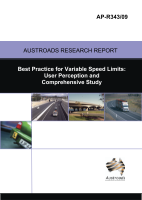Road Safety

Best Practice for Variable Speed Limits: User Perception and Comprehensive Study
- Publication no: AP-R343-09
- ISBN: 978-1-921551-71-0
- Published: 20 October 2009
- PDF (free) Download
Austroads project NS1378 Best Practice for Variable Speed Limits (VSL) aims to review both international and domestic VSL initiatives, recommend methods to achieve best practice in VSL design and operational issues, propose a consistent appearance so motorists can travel around Australasia and understand the VSL system, and share knowledge among practitioners and participants and encourage consistent VSL applications across jurisdictions. This report presents the results for the second task – driver perception and comprehension study.
- Project Manager
- . Introduction
- 1.1. Project Objectives and Tasks
- 1.2. Background to the User Comprehension and Perception Study
- 1.3. Contents of this Report
- . Method
- 2.1. Participants
- 2.2. Procedure and Materials
- 2.3. Concordance between Research Questions and Visual Material
- 2.3.1. Research Question 1
- 2.3.2. Research Question 2
- 2.3.3. Research Questions 3 and 4
- 2.3.4. Research Question 5
- Main findings
- Recommendations
- Other relevant issues
- 1. INTRODUCTION
- 2. METHOD
- 3. RESULTS
- 3.1. Familiarity with VSL
- 3.2. Use of Flashing Devices to Draw Attention to Lowered Speed Limit
- 3.2.1. Scenario 1 – Flashing Yellow Beacons
- 3.2.2. Scenario 2 – Flashing Annulus
- 3.2.3. Preferred Flashing Device
- 3.3. Meaning of Lane Control Symbols in Conjunction with Speed Limits
- 3.3.1. Scenario 3 – Two VSL/LCS over Every Lane, Speed Limits over Every Lane, LCS: Green Down Arrow, White Diagonal Arrow, Solid Red Cross
- 3.3.2. Scenario 4 – One VSL/LCS per Lane, Speed Limits over Lanes not Displaying LCS, LCS: Flashing Red Cross and Solid Red Cross
- 3.3.3. Scenario 5 – Green Arrows, Yellow Flashing Annulus and Solid Red Cross
- 3.3.4. Preferred Arrangement of VSL/LCS
- 3.4. Sign Failure
- 3.4.1. Scenario 6 – VSL over Every Lane, One Blank
- 3.4.2. Scenario 7 – Progression from all VSL Displayed to no VSL Displayed with no Default Speed Limit
- 3.4.3. Scenario 8 – Progression from all VSL Displayed to no VSL Displayed with a Default Speed Limit
- 3.5. Reasons Why VSL Might be Used
- 4. DISCUSSION
- 4.1. Effects of Age, Gender and City
- 4.2. Familiarity with VSL
- 4.3. Flashing Devices
- 4.4. Combined VSL/LCS
- 4.5. Sign Failure Modes
- 4.6. Responding to Real-time Traffic Conditions (Purpose of VSL)
- 5. CONCLUSIONS AND RECOMMENDATIONS
- 5.1. Main Findings
- 5.2. Recommendations
- 5.3. Related Issues
- 5.4. Further Research
- REFERENCES
Related publications
AP-R700-23
Latest Road Safety News
